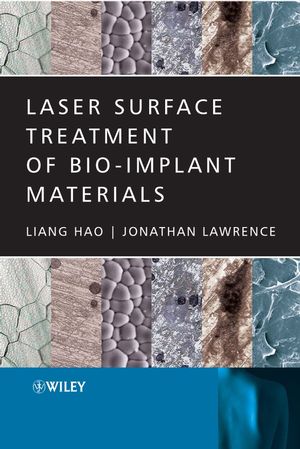Laser Surface Treatment of Bio-Implant MaterialsISBN: 978-0-470-01687-9
Hardcover
232 pages
November 2005
 |
||||||
Introduction.
1. Bioactivity and Biointegration of Orthopaedic and Dental Implants.
1.1. Introduction.
1.3. Biointegration of Orthopaedic and Dental Implants.
1.4. Controlling the Bone-Implant Interface.
2. Surface Modification of Biomaterials.
2.1. Introduction.
2.3. Metallic Implants.
2.4. Surface Modification of Biomaterials.
2.5. Laser Surface Modification of Biomaterials.
3. Wettability in Biomaterials Science and Modification Techniques.
3.1. Introduction.
3.2. Wettability, Adhesion and Bonding Theoretical Background.
3.3. Wettability in Biomaterial Science.
3.4. Current Methods of Wettability Modification.
3.5. Laser Wettability Characteristics Modification.
4. CO2 Laser Modification of the Wettability Characteristics of Magnesia Partially Stabilised Zirconia.
4.1. Introduction.
4.2. Experimental Procedures.
4.3. The Effects of CO2 Laser Radiation on Wettability Characteristics.
4.4. Surface Energy and its Component Parts.
4.5. Identification of the Predominant Mechanisms Active in Determining Wettability Characteristics.
4.6. The Role Played by Microstructures in Terms of Crystal Size and Phase in Effecting Surface Energy Changes.
4.7. Investigation of Wettability and Work Adhesion Using Physiological Liquids.
4.8. Summary.
5. In vitro Biocompatibility Evaluation of CO2 Laser Treated Magnesia Partially Stabilised Zirconia.
5.1. Introduction.
5.2. Sample Preparation.
5.3. Bone Like Apatite Formation.
5.4. Protein Adsorption.
5.5. Osteoblast Cell Response.
5.6. Predictions for Implantation in an in vivo Clinical Situation.
5.7. Summary.
6. The Effects of CO2 Laser Radiation on the Wettability Characteristics of a Titanium Alloy.
6.1. Introduction.
6.2. Experimental Procedures.
6.3. The Effects of CO2 Laser Radiation on Wettability Characteristics.
6.4. Surface Energy and its Component Analysis.
6.5. Identification of the Predominant Mechanisms Active in Determining Wettability Characteristics.
6.6. Investigation of Wettability and Work Adhesion Using Physiological Liquids.
6.7. Summary.
7. In vitro Biocompatibility Evaluation of CO2 Laser Treated Titanium Alloy.
7.1. Introduction.
7.2. Sample Preparation.
7.3. Bone Like Apatite Formation on Titanium Alloys.
7.4. Protein Adsorption.
7.5. Osteoblast Cell Adhesion.
7.6. Predictions for Implantation in an in vivo Clinical Situation.
7.7. Summary.
8. Enquiry into the Possible Generic Effects of the CO2 Laser Treatment on Bone Implant Biomaterials.
8.1. Introduction.
8.2. Ascertaining the Generic Effects of CO2 Laser Treatment on Bioinert Ceramics.
8.3. Ascertaining the Generic Effects of CO2 Laser Treatment on Metal Implants.
8.4. Summary.
Conclusions.
References.
Index.



